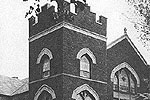
Grand Boulevard
— Washington Park (continued)
As black families replaced Irish and German workers, new institutions
emerged at the west end of Grand Boulevard. In 1897 blacks organized
St. Mary A.M.E. Church in rented
quarters at 4838 S. Armour (Federal) (See Fig. 1). Two
years later the congregation built a small frame church on Dearborn
near 49th Street. In 1900
a group of blacks purchased the old State Street Methodist Church
near 47th Street and renamed it St. Mark's. This congregation
included a number of property owners who banded together in 1905
to force local saloons to close at midnight. Black homeowners
believed that eight saloons on 47th Street between Federal and
State were too many, but they were powerless to change the long-established
character of this strip.
White homeowners who lived on Dearborn Street south of Garfield
Boulevard (55th Street) reacted to racial change in the area by
petitioning the City Council in 1901 to rename their street Lafayette.
According to the Stockyards Sun, Dearborn Street between 22nd
and 55th Streets "has become synonymous with the colored
community." The name change notwithstanding, Lafayette between
55th and 59th Streets soon became an enclave of black homeowners.
The 5700 block had once formed the grounds of the John Raber estate,
which dated from the 1860s. The original house, though somewhat
altered, is still standing at 5760 S. Lafayette. By the 1920s
blacks owned twenty-two of the twenty-four houses in this block
of Lafayette, and they worked to beautify their neighborhood by
planting gardens, whitewashing trees, and removing fences from
all front yards.
The black population of Chicago grew dramatically during World
War I as thousands of Southern blacks sought Jobs in the city's
packing houses and steel mills. Although a black community had
existed along Dearborn Street since the 1890s, white families
living west of the Rock Island Railroad tracks vigorously resisted
the attempts of blacks to settle in their neighborhood. During
the Race Riot of July 1919, white gangs burned down homes west
of Wentworth that were owned or rented by blacks. After the riot
black families were afraid to return to the district, and for
the next thirty years Wentworth Avenue remained the dividing line
between white and black neighborhoods.
«
previous
8
of 14
next
»
|
 |

|
 |


Figure
1: St. Mary A.M.E. Church, 5251 S. Dearborn. »
|